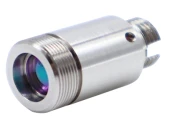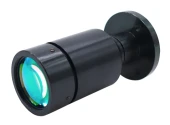Description
The GKER Photonics Multimode Single Fiber Collimator (GK-MMC Series) is a crucial component for high-performance optical systems, designed to provide precise collimation of light from multimode fibers. As a foundational element in in-line fiber optic components such as isolators and wavelength division multiplexers (WDM), this collimator ensures optimal signal transmission with low insertion loss and high return loss.
The GK-MMC Series is engineered with advanced manufacturing techniques and superior anti-reflective (AR) coatings, which enable the collimator to manage high optical power with exceptional stability and efficiency. Available in various center wavelengths including 1310 nm and 1550 nm, this collimator offers flexibility for integration into a wide range of optical communication systems, testing equipment, and industrial automation applications.
The product features customizable options, allowing users to specify parameters such as lens diameter, working distance, connector type, fiber jacket, and fiber core size. The collimator is built to endure harsh environments, with an operating temperature range of -5°C to +70°C and a storage temperature range of -40°C to +85°C, making it suitable for both indoor and outdoor installations.
Whether you're working on complex optical networks or laser-based systems, the GKER Photonics Multimode Single Fiber Collimator provides reliable, high-performance solutions tailored to meet your specific needs.
1310 -1550nm Multimode Single Fiber Collimator
Specifications
| Center Wavelength (λc): | 1310, 1550, or, specified nm |
|---|---|
| Operating Wavelength Range: | λc ± 30 nm |
| Working Distance: | 5, or specified mm |
| Typ. Insertion Loss: | 0.20 dB |
| Max. Insertion Loss: | 0.25 dB |
| Min. Return Loss: | 35 dB |
| Max. Tensile Load: | 5 N |
| Fiber Type: | Multimode Fiber 105/125, 62.5/125, 50/125 µm, or specified - |
| Operating Temperature: | - 5 to + 70 ℃ |
| Storage Temperature: | - 40 to + 85 ℃ |
Features
- Low Insertion Loss: Ensures minimal signal loss with a typical insertion loss of 0.20 dB
- High Return Loss: Provides excellent signal reflection with a minimum return loss of 35 dB
- High Power Handling: Advanced AR coating allows the collimator to handle high optical power efficiently
- Customizable Options: Offers various customization options for wavelength, lens diameter, connector type, and more
Applications
- Optical Communication Systems: Ideal for enhancing signal transmission in optical networks
- Laser Applications: Suitable for precise laser systems requiring efficient light collimation
- Industrial Automation: Supports automation systems with high-performance optical components
Frequently Asked Questions
What is the typical insertion loss of the Multimode Single Fiber Collimator?
What center wavelengths are available for this collimator?
Can this collimator handle high optical power?
What is the operating temperature range for this collimator?
Is the collimator customizable?
What applications is this collimator suitable for?
What is the minimum return loss for the collimator?
How is the collimator designed to withstand environmental conditions?
What fiber types are compatible with this collimator?
How does the working distance affect the collimator's performance?
Similar Products












Your inquiry has been received.
Create an account by adding a password
Why create an account?
- Auto-complete inquiry forms
- View and manage all your past messages
- Save products to your favorites
- Close your account anytime — no hassle
